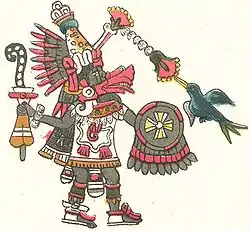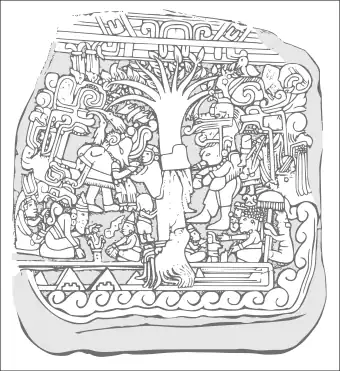White gods
White gods is the belief that ancient cultures around the world were visited by white races in ancient times, and that they were known as "white gods".
 Some see Quetzalcoatl as a possible white god. | |
| Claims | Native Americans made contact with pre-Columbian European explorers, influencing their religions and culture. |
|---|---|
| Related scientific disciplines | Archaeology |
| (Overview of pseudoscientific concepts) | |
Some authors have claimed that white missionaries or "gods" visited America before Christopher Columbus. Authors usually quote from mythology and legends which discuss ancient gods such as Quetzalcoatl to conclude that the legends were actually based on Caucasians visiting those areas, and that the Caucasians were really the gods.[1][2]
This story was first reported by Pedro Cieza de León (1553) and later by Pedro Sarmiento de Gamboa. Similar accounts by Spanish chroniclers (e.g. Juan de Betanzos) describe Viracocha as a "white god", often with a beard.[3]
The first Spanish chroniclers from the 16th century, however, made no mention of any identification with Viracocha. The first to do so was Pedro Cieza de León in 1553.[4] Similar accounts by Spanish chroniclers (e.g. Juan de Betanzos) describe Viracocha as a "white god", often with a beard.[5] The whiteness of Viracocha is however not mentioned in the native authentic legends of the Incas. Most modern scholars, therefore, had considered the "white god" story to be a post-conquest Spanish invention. [6]
Proponents
Rupert Furneaux also linked "White gods" to the ancient city of Tiahuanaco.[7]
Colonel A. Braghine in his 1940 book The Shadow of Atlantis claimed that the Carib people have reports and legends of a white bearded man whom they called Tamu or Zune who had come from the East, taught the people agriculture and later disappeared in an "easterly direction".[8] Braghine also claimed Manco Cápac was a white bearded man.[9] The Atlantis author Gerd von Hassler linked the "White gods" to the biblical flood.[10]
Acclaimed Norwegian explorer Thor Heyerdahl, best known for his voyage across the Pacific in a reconstruction of an ancient vessel in an effort to prove that Polynesia was peopled by South American voyagers, believed that a white race inhabited South America.[11]
The archaeologist Pierre Honoré in 1962 proposed the fringe theory that the pre-Columbian Mesoamerican civilizations were due to "white men from the vicinity of Crete".[12]
The writer and treasure-hunter Robert F. Marx has written extensively about the concept of "White gods". Marx came to the conclusion that white gods "figure in almost every indigenous culture in the Americas."[13][14]
The British writer Harold T. Wilkins took the concept of the white gods the furthest, writing that a vanished white race had occupied the whole of South America in ancient times.[15] Wilkins also claimed that Quetzalcoatl was from Atlantis.[16][17]
The occultist James H. Madole, influenced by Aryanism and Hinduism, wrote that the Aryan race was of great antiquity and had been worshipped worldwide by lower races as "white gods". Madole also wrote that the Aryans originated in the Garden of Eden located in North America.[18]
Most modern scholars consider the "White god legends" to be a post-conquest Spanish invention and that the ideas are based on pseudoscience.[19][20]
Beliefs of the Church of Jesus Christ of Latter Day Saints

Some Mormons believe that Quetzalcoatl, a figure described as white and bearded, who came from the sky and promised to return, was likely Jesus Christ. According to the scriptural account recorded in the Book of Mormon, Jesus Christ visited and taught natives of the Americas following his resurrection, and regarded them as the "other sheep" whom he had referenced during his mortal ministry. The Book of Mormon also claims that Jesus Christ appeared to others, following his resurrection, even to the inhabitants on the "isles of the sea."[21] With regard to the Mexican legend, LDS Church President John Taylor wrote:
The story of the life of the Mexican divinity, Quetzalcoatl, closely resembles that of the Savior; so closely, indeed, that we can come to no other conclusion than that Quetzalcoatl and Christ are the same being.[22]
This idea was adapted by Mormon science fiction author Orson Scott Card in his story "America".
Ancient astronauts
Some Ancient astronaut and UFO writers have claimed the "white gods" were actually extraterrestrials. Peter Kolosimo believed that the legends of Quetzalcoatl had a basis in fact. He claimed that the legends actually describe a race of white men who were born in spaceships and migrated to Atlantis; then, after Atlantis was destroyed, they moved to the Americas to be treated as "white gods" by the "primitive earth-dwellers".[23]
See also
Further reading
- Magelssen, S. (2016). "White-Skinned Gods: Thor Heyerdahl, the Kon-Tiki Museum, and the Racial Theory of Polynesian Origins". TDR/The Drama Review, 60(1), 25–49.
References
- MacKenzie, Donald A. (April 2003). Myths of Pre-Columbian America – Donald A. MacKenzie – Google Books. Kessinger. ISBN 9780766148314. Retrieved 26 October 2013.
- Stein, Henry Binkley (1940). Thirty Thousand Gods Before Jehovah – Henry Binkley Stein – Google Books. Health Research Books. ISBN 9780787310905. Retrieved 26 October 2013.
- Pre-Columbian America: Myths and Legends, Donald. A. Mackenzie, Senate, 1996, p.268-270
- Colonial Spanish America: a documentary history, Kenneth R. Mills, Rowman & Littlefield, 1998, p. 39.
- Pre-Columbian America: Myths and Legends, Donald. A. Mackenzie, Senate, 1996, p.268-270
- Mills, 1998, p. 40.
- Rupert Furneaux, Ancient Mysteries, Ballantine Books, 1987, p. 154
- Braghine, A. (October 2004). The Shadow of Atlantis 1940 – A. Braghine – Google Books. Kessinger. ISBN 9781417976782. Retrieved 26 October 2013.
- Braghine, The Shadow of Atlantis, p. 34
- Gerd Von Hassler, Lost Survivors of the Deluge, 1980 pp. 63 – 81 ISBN 0-451-08365-2
- Magelssen, Scott (2016). "White-Skinned Gods: Thor Heyerdahl, the Kon-Tiki Museum, and the Racial Theory of Polynesian Origins". TDR/The Drama Review. 60 (1): 25–49. doi:10.1162/DRAM_a_00522. S2CID 57559261.
- Pierre Honoré, In quest of the white god: the mysterious heritage of South American civilization, Futura Publications (1962). In 2007, the book was reprinted as In Search of Quetzalcoatl: The Mysterious Heritage of American Civilization. The 2007 edition can be found online at google books.
- Jonathan Kirsch (22 January 1992). "BOOK REVIEW : Memoir Masquerades as History in 'Quest of Great White Gods' : IN QUEST OF THE GREAT WHITE GODS, Contact Between the Old and New World From the Dawn of History by Robert F. Marx with Jenifer G. Marx". Los Angeles Times. Retrieved 2 August 2012.
- Robert Marx, In quest of the great white gods: contact between the Old and New World from the dawn of history, Crown, 1992
- The Pan American, Volume 7, Famous Features Syndicate, 1946, p. 11 "Harold T. Wilkins Legend of a Fabulous Empire" discusses Wilkins belief about a "strange white race living in lost cities, amidst the crumbling ruins of once splendid palaces and temples in South America"
- Childress, David Hatcher (1992). Lost Cities of North & Central America – David Hatcher Childress – Google Books. Adventures Unlimited Press. ISBN 9780932813091. Retrieved 26 October 2013.
- Wilkins, Harold T. (2000). Mysteries of Ancient South America – Harold T. Wilkins – Google Books. Adventures Unlimited Press. ISBN 9780932813268. Retrieved 26 October 2013.
- Nicholas Goodrick-Clarke, Black Sun: Aryan Cults, Esoteric Nazism, and the Politics of Identity, 2003 p. 81
- The Skeptic Encyclopedia of Pseudoscience, "White god legends", Michael Shermer, ABC-CLIO, 2002, p. 578.
- Mills, 1998, p. 40.
- Wirth, Diane E. (2002), "Quetzalcoatl, the Maya maize god and Jesus Christ", Journal of Book of Mormon Studies, Provo, Utah: Maxwell Institute, 11 (1): 4–15, doi:10.5406/jbookmormstud.11.1.0004, S2CID 193717645, archived from the original on 17 February 2009, retrieved 14 June 2011
- Taylor, John (1892) [1882], An Examination into and an Elucidation of the Great Principle of the Mediation and Atonement of Our Lord and Savior Jesus Christ, Deseret News, p. 201
- Peter Kolosimo, Timeless Earth, 1977 pp. 153 – 154 ISBN 0-7221-5329-5